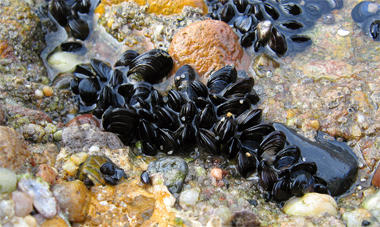There are molluscs that produce a glue that can hold tightly to metal and stone, even in water. Chemists copied the protein responsible for this into a synthetic material containing the same adhesive properties.

Chemists can study shellfish. Snails, for example, produce a glue capable of holding tightly to metal and stone, even in water. Chemists copied the the protein responsible for this into a synthetic material containing the same adhesive properties. Regardless of whether the material consists entirely or only partially of this protein, the quality of the adhesion is the same.
These findings were discovered by researchers from the Max Planck Institute for Polymer Research and Gutenberg University in Mainz, Germany. It is possible and possible to use about ninety percent of the unused polymers for a durable bond in other areas by mixing them with chemical additives that allow adhesion to surfaces other than metal or stone.
Some molluscs have a hard life: when they are located on the seabed close to the shore, the tidal forces of the waves act on them regularly. In order not to be swept away by the raging waves, the molluscs use special proteins to properly attach themselves to safe ground - an ability that engineers still struggle to achieve - adhesion in water. The molluscs manage to do so thanks to the amino acid dihydroxyphenylalanine, also known by its short name Dopa (Dihydroxyphenylalanine). Its chemical structure allows the creation of extremely strong bonds with metals and minerals and it is included in the adhesion proteins with which the molluscs cling to the seabed.
Scientists from the University of Mainz have now succeeded in replicating the mollusk's adhesion proteins as artificial polymers. These include long chains of furodes and contain the same chemical additives that make the mollusc proteins sticky. As the researchers from the university have now discovered, the number of units in the chain carrying the linking units (dopa) has no overall effect on the nature of the chain's adhesion, provided that their amount is not less than ten percent of the entire chain.
The researchers measured the force required to tear off different polymer chains from the surface. They examined chains containing only the dopa units (100%) and others whose amount of units was only about a fifth or a tenth of that. The force required to tear off a single polymer from the surface was always constant - 67 piconewtons. This force alone cannot keep the mollusk at the bottom of the sea. However, these creatures bind themselves tightly with a small amount of material containing a huge amount of polymer chains, so that they are able to resist the movement of the waves.
"The fact that the nature of the adhesion, to a certain extent, does not depend on the number of cross-linking sites could allow other functions to be assigned to the vacant sites in the polymer," say the researchers. For example, chemists will be able to produce a polymer that can adhere equally to different materials. The Dopa group binds mainly to metals and minerals. Chemists will be able to provide other bonds in the polymer chain with additives that can also bind to wood, glass or bones. "New adhesives that can bind metals and bones will be interesting in the field of anchoring artificial joints to the body," adds one of the researchers.
Initially, the researchers wondered why the adhesive strength of the polymer chains was essentially independent of the number of cross-linking sites. "Normally, we imagine the adhesive polymer as a kind of adhesive tape that binds along its entire length," say the researchers. However, the more adhesive paper that sticks to the surface, the harder it is to tear it off. This model, which describes the adhesion of a polymer as a continuous force, does not match the activity of the mollusk adhesion proteins or their artificial copies.
"We imagine our polymers as chains of individual binding sites linked together like loose springs," says the lead researcher. When they tore them apart, he and his team measured only the strength of a single binding site anchored to the surface. The degree of density of the link sites in the chain thus becomes ineffective. This degree of density will have an effect if the applied force is distributed evenly along the entire length of the polymer and does not act from one end to the other. "Practically, this only happens when the surface is completely flat," explains the researcher. "Most surfaces are rough, at their nanometer level, so wear applied to one end will always affect it more than the other."
The scientists designed their experiment so that it could shed light on this disconnection process. They placed a monolayer of the polymer on a titanium surface. Using the titanium tip of an atomic force microscope, which measures only a few nanometers, they lifted a single chain of the polymer in a similar way to lifting a single thread from a table with your fingers. So they pulled the tip out and measured the force required to do so. They found that a force of 67 piconewtons was required to break the bond between the titanium surface and the active groups in the polymer. Since the polymer itself also behaves as a loose spring, the degree of force remains similar even for breaking the bond next in line, so that during the disconnection the applied force remains constant, more or less. The researchers are now interested in using the findings obtained from this experiment to produce polymers with binding sites for other substances.
